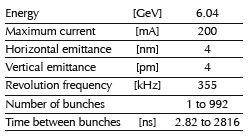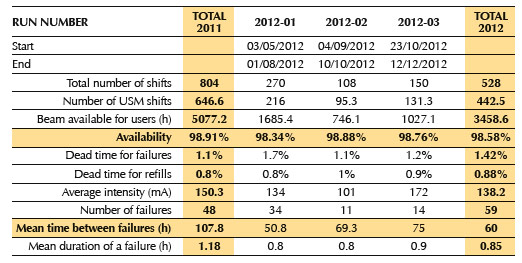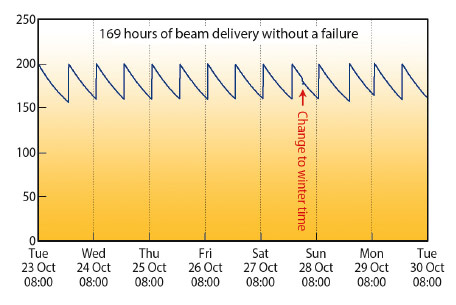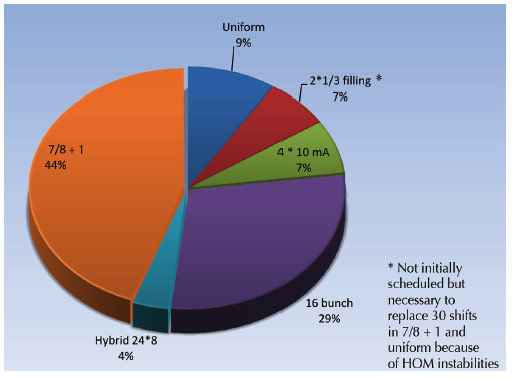- Home
- Users & Science
- Scientific Documentation
- ESRF Highlights
- ESRF Highlights 2012
- Accelerator and X-ray Source
Accelerator and X-ray Source
In 2012 the Accelerator complex was stopped for a period of five months due to the extensive building works in progress for Phase I of the ESRF Upgrade Programme. The Accelerator and Source Division put to profit this long shutdown to continue its efforts to ensure reliable operation by upgrading a number of systems. The major developments of 2012 are described hereafter.
Beam parameters of the storage ring
A summary of the characteristics of the storage ring electron beam, the main optic functions, electron beam sizes and divergences at various source points are presented in Table 1 and Table 2. For insertion device source points, the beta functions, dispersion, sizes and divergences are calculated in the middle of the straight section. For bending magnets two representative source points have been selected for each type (even or odd cell number) of magnet, corresponding to magnetic fields of 0.4 T and 0.85 T. These points differ by the observation angles, of respectively 3 and 9 mrad from the entrance of the magnet.
 |
|
Table 1: Principal characteristics of the electron beam. |
Electron beam profiles are Gaussian and the size and divergence are presented in terms of rms values. The associated full width at half maximum sizes and divergences are 2.35 times higher. Horizontal electron beam sizes and divergences are given for the multibunch filling modes and apply to almost all filling patterns except when the current per bunch is larger than 4.5 mA, for which a slightly larger size and divergence are attained because of the increased energy spread of the electron beam.
Vertical electron beam sizes and divergences are given for a vertical emittance of 4 pm, which is now the standard for 2 x 1/3 and 7/8+1 filling modes. The vertical sizes and divergences are about 1.4 times larger in uniform filling mode (due to ion effects, which are partially corrected by the use of a vertical bunch by bunch feedback). To increase the lifetime of the stored beam, the vertical beam sizes and divergences are deliberately increased by about a factor of 4 in the 16-bunch, 4-bunch and hybrid filling patterns.
 |
|
Table 2: Beta functions, dispersion, rms beam size and divergence at the various source points. |
The lifetime, bunch length and energy spread mainly depend on the filling pattern. These are given in Table 3 for a few representative patterns. Note that in both 16-bunch and 4-bunch filling patterns, the energy spread and bunch length decay with the current (the value indicated in the table corresponds to the maximum current). The bunch lengths are given for the usual radio-frequency accelerating voltage of 9 MV (8 MV for 16-bunch and 4-bunch).
 |
|
Table 3: Current, lifetime, bunch length and energy spread for a selection of filling modes. |
Summary of accelerator operation
Due to the exceptionally long shutdown, from 5th December 2011 to 3rd May 2012, user runs in 2012 were different in distribution and duration compared to a normal year of operation. Three runs were scheduled in 2012 instead of the usual five. An overview is presented in Table 4.
 |
|
Table 4: Overview of storage ring operation in 2012. |
During the long shutdown, numerous modifications and improvements were implemented on several parts of the accelerator as well as on the facility networks such as fluids and electricity. The accelerator alignment was disturbed by substantial ground movement linked to earth removal and important building works underway on site. To troubleshoot and anticipate possible difficulties for the May restart, one week was dedicated to an intermediate restart of the accelerator complex in March 2012. This proved extremely fruitful since it helped to solve several unforeseen problems, facilitating the user mode restart in May.
At the beginning of the May restart, several days were devoted to extensive radiation and personnel safety system checks for all the beamlines. Several problems were also found and solved in the front-ends when the X-ray beam was delivered to the users.
In 2012, 442.5 shifts (3540 hours) of beam time had been initially scheduled for the users. Of these 3540 hours, 3459 were effectively delivered (including 31.2 hours of refill). This represents a beam availability of 98.58%, which is slightly lower than for 2011 (98.91%). Indeed, over the three runs several beam interruptions clocked beam downtime in the region of 2-3 hours (PSS beamline trips, water leak on a crotch, failure of one regulation rack on a power supply of one sextupole family, lightning strike on site, etc.). The mean time between failures (MTBF) for this year reached 60 hours, which is also lower compared to 2011 (107.8 hours). The origin of this reduced MTBF is mainly due to commissioning of new hardware and software implemented during the long shutdown. In particular the RF system had to be reconditioned and the fast orbit feedback debugged. Due to the variety and complexity of installations carried out during the shutdown, some failures resulted from the run-in. These were discovered and fixed over the three runs.
Despite statistics that are worse than in 2011, there were several periods when the beam was delivered for several days without a single interruption. In particular, during week 43 which counted 7 days of delivery instead of the usual 6, when the beam was delivered for 169 hours with 1 additional hour due to the changeover to winter time (see Figure 146).
 |
|
Fig. 146: Uninterrupted beam delivery for 169 hours in 7/8 + 1 filling mode during week 43 (RUN 2012- 03). |
Filling patterns
Figure 147 presents the distribution of filling modes delivered in 2012. Due to the long shutdown, only 3672 hours of USM were scheduled in 2012 instead of 5600 hours scheduled in a usual year of operation. Uniform filling mode remains limited to specific user requirements whilst the preferred standard mode continues to be “7/8 +1” filling mode. This mode undoubtedly offers the best compromise satisfying the majority of the different user communities.
 |
|
Fig. 147: Distribution of the various filling modes in 2012. |
During the 6th week of operation, the beam was delivered in uniform filling mode as expected for the first two days. Unfortunately, strong Higher Order Mode (HOM) instabilities appeared during the decays and could not be eliminated through equipment tuning. At the same time, the medical beamline had scheduled its first patients making it essential to deliver a stable and reliable beam. It was therefore decided to switch to 2/3 filling mode to obtain the best conditions of beam quality. Not a single failure occurred over the next days when the patients were being treated.



